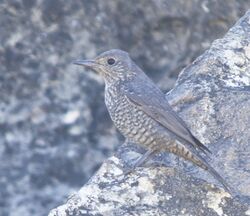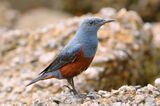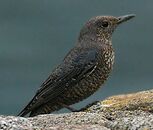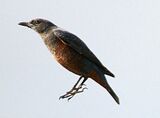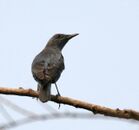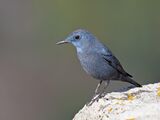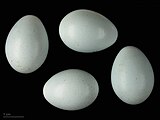Biology:Blue rock thrush
| Blue rock thrush | |
|---|---|
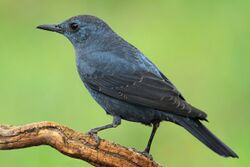
| |
| Male M. s. solitarius | |

| |
| Female M. s. solitarius | |
| Scientific classification | |
| Domain: | Eukaryota |
| Kingdom: | Animalia |
| Phylum: | Chordata |
| Class: | Aves |
| Order: | Passeriformes |
| Family: | Muscicapidae |
| Genus: | Monticola |
| Species: | M. solitarius
|
| Binomial name | |
| Monticola solitarius | |
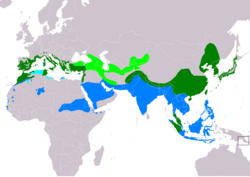
| |
| Range of M. solitarius Breeding Resident Passage Non-breeding Vagrant (seasonality uncertain)
| |
| Synonyms | |
|
Turdus solitarius Linnaeus, 1758 | |
The blue rock thrush (Monticola solitarius) is a species of chat. This thrush-like Old World flycatcher was formerly placed in the family Turdidae. It breeds in southern Europe, northwest Africa, and from Central Asia to northern China and Malaysia. The blue rock thrush is the official national bird of Malta (the word for it in Maltese being Merill) and was shown on the Lm 1 coins that were part of the country's former currency.
Taxonomy
The blue rock thrush was described by Carl Linnaeus in 1758 in the 10th edition of his Systema Naturae under the binomial name Turdus solitarius.[2][3] The scientific name is from Latin. Monticola is from mons, montis "mountain", and colere, "to dwell", and the specific epithet solitarius means "solitary".[4]
The rock thrush genus Monticola was formerly placed in the family Turdidae[5] but molecular phylogenetic studies have shown that the species in the genus are more closely related to members of the Old World flycatcher family Muscicapidae.[6]
There are five recognised subspecies:[7][8]
- M. s. solitarius (Linnaeus, 1758) – northwest Africa, south Europe, north Turkey to Georgia and Azerbaijan.
- M. s. longirostris (Blyth, 1847) – Greece and west and south Turkey through the Middle East to the northwest Himalayas to northeast Africa and India
- M. s. pandoo (Sykes, 1832) – central Himalayas to east China and north Vietnam to Greater Sunda Islands
- M. s. philippensis (Statius Müller, 1776) – east Mongolia to Sakhalin south to Japan, extreme north Philippines and northeast China to Indonesia
- M. s. madoci Chasen, 1940 – Malay Peninsula and north Sumatra
There is a proposal to split Monticola solitarius into two species: a western taxon comprising M. s. solitarius and M. s. longirostris and an eastern taxon with M. s. philippensis, M. s. pandoo and M. s. madoci.[9]
Description
The blue rock thrush is a starling-sized bird, 21–23 cm (8.3–9.1 in) in length with a long slim bill. The breeding male of the nominate subspecies is unmistakable, with all blue-grey plumage apart from its darker wings.[8] Females and immatures are much less striking, with dark brown upperparts, and paler brown scaly underparts. The male of the subspecies M. s. philippensis has rufous-chestnut plumage from the mid-breast down to the undertail.[8] Both sexes lack the reddish outer tail feathers of rock thrush.
The male blue rock thrush sings a clear, melodious call that is similar to, but louder than, the call of the rock thrush.
Distribution and habitat
The European, north African and southeast Asian birds are mainly resident, apart from altitudinal movements. Other Asian populations are more migratory, wintering in sub-Saharan Africa, India and southeast Asia. This bird is a very uncommon visitor to northern and western Europe.
Behaviour
Blue rock thrush breeds in open mountainous areas. It nests in rock cavities and walls, and usually lays 3-5 eggs. An omnivore, the blue rock thrush eats a wide variety of insects and small reptiles in addition to berries and seeds.[8]
Gallery
References
- ↑ BirdLife International (2016). "Monticola solitarius". IUCN Red List of Threatened Species 2016: e.T22708286A87933903. doi:10.2305/IUCN.UK.2016-3.RLTS.T22708286A87933903.en. https://www.iucnredlist.org/species/22708286/87933903. Retrieved 13 November 2021.
- ↑ Linnaeus, C. (1758) (in la). Systema naturae per regna tria naturae, secundum classes, ordines, genera, species, cum characteribus, differentiis, synonymis, locis. Tomus I. Editio decima, reformata. 1. Holmiae:Laurentii Salvii. p. 170. https://www.biodiversitylibrary.org/page/727077.
- ↑ Mayr, Ernst; Paynter, Raymond A. Jr. (1964). Check-list of Birds of the World. Volume 10. 10. Cambridge, Massachusetts: Museum of Comparative Zoology. p. 138. https://www.biodiversitylibrary.org/page/14486327.
- ↑ Jobling, James A. (2010). The Helm Dictionary of Scientific Bird Names. London, United Kingdom: Christopher Helm. pp. 260, 359. ISBN 978-1-4081-2501-4. https://archive.org/details/Helm_Dictionary_of_Scientific_Bird_Names_by_James_A._Jobling..
- ↑ Dickinson, E.C., ed (2003). The Howard and Moore Complete Checklist of the Birds of the World (3rd ed.). London: Christopher Helm. ISBN 978-0-7136-6536-9.
- ↑ Sangster, G.; Alström, P.; Forsmark, E.; Olsson, U. (2010). "Multi-locus phylogenetic analysis of Old World chats and flycatchers reveals extensive paraphyly at family, subfamily and genus level (Aves: Muscicapidae)". Molecular Phylogenetics and Evolution 57 (1): 380–392. doi:10.1016/j.ympev.2010.07.008. PMID 20656044.
- ↑ Gill, Frank; Donsker, David, eds (2016). "Chats, Old World flycatchers". World Bird List Version 6.2. International Ornithologists' Union. http://www.worldbirdnames.org/bow/chats/.
- ↑ 8.0 8.1 8.2 8.3 Collar, N. (2020). "Blue Rock-thrush (Monticola solitarius)". in del Hoyo, J.; Elliott, A.; Sargatal, J. et al.. Handbook of the Birds of the World Alive. Lynx Edicions. doi:10.2173/bow.burthr.01. http://www.hbw.com/node/58415. Retrieved 9 July 2016.(Subscription content?)
- ↑ Zuccon, D.; Ericson, Per G.P. (2010). "The Monticola rock-thrushes: phylogeny and biogeography revisited". Molecular Phylogenetics and Evolution 55 (3): 901–910. doi:10.1016/j.ympev.2010.01.009. PMID 20079862.
External links
- Blue rock thrush videos, photos & sounds on the Internet Bird Collection
- Ageing and sexing by Javier Blasco-Zumeta & Gerd-Michael Heinze
- Xeno-canto: audio recordings of the blue rock thrush
Wikidata ☰ Q152144 entry
 |

